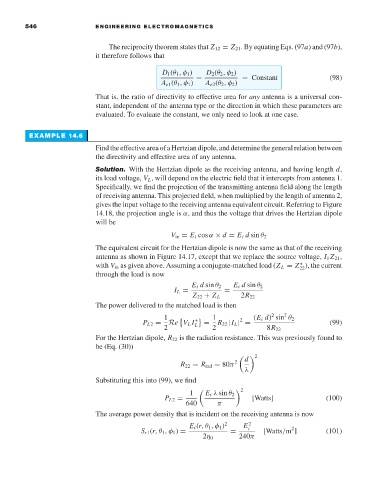Page 564 - Engineering Electromagnetics, 8th Edition
P. 564
546 ENGINEERING ELECTROMAGNETICS
The reciprocity theorem states that Z 12 = Z 21 .By equating Eqs. (97a) and (97b),
it therefore follows that
D 1 (θ 1 ,φ 1 ) D 2 (θ 2 ,φ 2 )
A e1 (θ 1 ,φ 1 ) = A e2 (θ 2 ,φ 2 ) = Constant (98)
That is, the ratio of directivity to effective area for any antenna is a universal con-
stant, independent of the antenna type or the direction in which these parameters are
evaluated. To evaluate the constant, we only need to look at one case.
EXAMPLE 14.6
Find the effective area of a Hertzian dipole, and determine the general relation between
the directivity and effective area of any antenna.
Solution. With the Hertzian dipole as the receiving antenna, and having length d,
its load voltage, V L , will depend on the electric field that it intercepts from antenna 1.
Specifically, we find the projection of the transmitting antenna field along the length
of receiving antenna. This projected field, when multiplied by the length of antenna 2,
gives the input voltage to the receiving antenna equivalent circuit. Referring to Figure
14.18, the projection angle is α, and thus the voltage that drives the Hertzian dipole
will be
V in = E i cos α × d = E i d sin θ 2
The equivalent circuit for the Hertzian dipole is now the same as that of the receiving
antenna as shown in Figure 14.17, except that we replace the source voltage, I 1 Z 21 ,
with V in as given above. Assuming a conjugate-matched load (Z L = Z ), the current
∗
22
through the load is now
E i d sin θ 2 E i d sin θ 2
I L = =
Z 22 + Z L 2R 22
The power delivered to the matched load is then
2
2
1 1 (E i d) sin θ 2
2
P L2 = Re V L I L ∗ = R 22 |I L | = (99)
2 2 8R 22
For the Hertzian dipole, R 22 is the radiation resistance. This was previously found to
be (Eq. (30))
d
2
2
R 22 = R rad = 80π
λ
Substituting this into (99), we find
1 E i λ sin θ 2 2
P L2 = [Watts] (100)
640 π
The average power density that is incident on the receiving antenna is now
E i (r,θ 1 ,φ 1 ) 2 E 2
2
S r1 (r,θ 1 ,φ 1 ) = = i [Watts/m ] (101)
2η 0 240π

